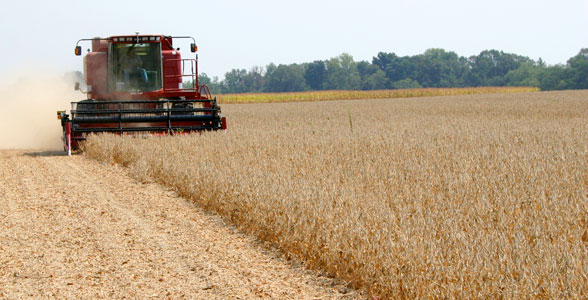By Ginger Trice
The Gulf Dead Zone—an 8,000-square-mile area near the U.S. Gulf coast where oxygen levels are too low to support marine life—is blamed on agricultural runoff that enters the Mississippi River and its tributaries hundreds of miles upstream.
Scientists at the UT Institute of Agriculture may improve water quality in the Gulf by research totally unrelated to water. They’re working on a new kind of soybean.
In an article recently published in the journal Crop Science, researchers outline a method that allows them to select for a certain trait in soybean breeding. This trait is beneficial to the growth and development of farm animals that consume feed made from soybeans, and it boosts the efficiency of livestock operations. An added plus is that this characteristic can also reduce phosphorus pollution, leading to cleaner ground and surface waters.
According to studies, much of the problem in the Gulf Dead Zone is the result of nitrogen and phosphorus contamination, with a significant portion of the phosphorus coming from animal waste. This contamination can lead to excessive plant growth and decay in aquatic ecosystems and a reduction in available oxygen for fish and other organisms. Some experts say livestock feed contributes to the problems in the Dead Zone. The U.S. Geological Survey recently named Tennessee as one of the chief polluting watersheds that contribute to the Dead Zone.
Feed made from soybeans contains a form of phosphorus called phytate. As UT plant sciences professor Dr. Vince Pantalone explains, high levels of the phytate compound can be bad news to animals and the environment.
“Phytate is not digested and not absorbed by animals like poultry and swine,” says Pantalone. “So two things happen. One, the feeding animal doesn’t benefit because it doesn’t get good nutrition from the minerals. The second thing is, because the animal doesn’t digest this phytate, it is excreted in manure. If you spread chicken manure on agricultural land, soil bacteria break that up and then release inorganic phosphate, and that can contribute to phosphorus contamination in ground water, lakes, streams, and rivers. And that can be a really serious pollution problem.”
So Pantalone, along with Dr. Dennis West and Dr. Carl Sams from the UT Plant Sciences department, as well as Dr. Forbes Walker from the UT Biosystems Engineering and Soil Science department set out to develop a “low‐phytate” soybean—a soybean that would be more digestible by animals, thus reducing phosphorus contamination in manure and eventual run‐off and contamination in water. To do this would mean locating the low‐phytate trait within the soybean’s DNA, which is just what they did.
“Using molecular genetic markers, scientists have found that in soybeans there are two recessive genes for low levels of phytate,” says Pantalone. “And working along with the University of Georgia, we have confirmed the particular chromosome and the particular spot on the chromosome where those genes are located.”
According to Pantalone, UTIA researchers will be able to use these markers to cross low‐phytate plants with normal plants. The markers will then help track which specific progeny inherit both genes.
“If we get these two genes together, that will actually reduce the phytate level by about four times,” says Pantalone. “The phosphorus level remains stable, so it allows the feeding animals to benefit from the total phosphorus, [but] the phosphorus is no longer in a bound, indigestible form. The animal feeds, it can use the phosphorus, it’s absorbed, it’s metabolized, and it doesn’t pass out in the manure.”
The study could have a huge impact in the Volunteer State, which, according to the Tennessee Department of Agriculture, is home to more than 200 million chickens and ranks 13th in the nation for broiler production.
The development of soybeans that are lower in seed phytate should improve the availability of mineral nutrients to these growing animals and at the same time reduce runoff damage to ecosystems in Tennessee’s waterways. And of course Tennessee’s waterways eventually flow into the Mississippi River and the Gulf of Mexico. Relief for the effects of the Gulf Dead Zone could potentially start with a soybean seed in Tennessee.
While low‐phytate soybeans are not on the market yet, varieties are being tested at several AgResearch and Education Centers across the state including Milan, Highland Rim, and East Tennessee. At these outdoor laboratories, scientists can evaluate the soybeans under real life conditions. UT Institute of Agriculture researchers say they will use the new breeding technology to continue development of a low‐phytate soybean that will be marketable and economical for farmers. Even for non‐farmers, it’s something to get excited about—better water that starts with better beans.




